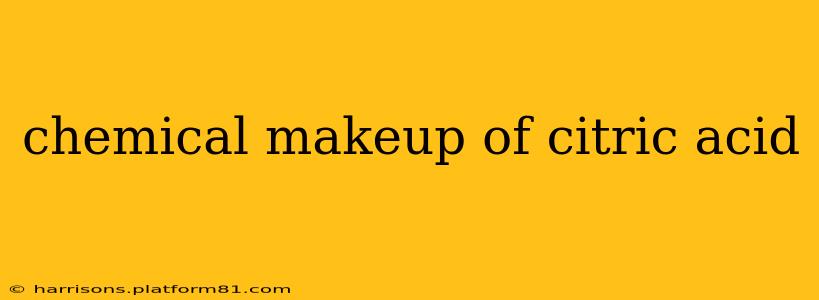Citric acid, a ubiquitous weak organic acid found in citrus fruits, plays a vital role in various industries, from food and beverages to pharmaceuticals and cleaning products. Understanding its chemical makeup is crucial to appreciating its diverse applications and properties. This article will delve into the chemical structure, properties, and production of citric acid, answering common questions along the way.
What is the chemical formula of citric acid?
The chemical formula for citric acid is C₆H₈O₇. This formula indicates that each molecule of citric acid contains six carbon atoms, eight hydrogen atoms, and seven oxygen atoms. However, this formula alone doesn't fully describe the molecule's structure; that requires a more detailed look.
What is the chemical structure of citric acid?
Citric acid is a tricarboxylic acid, meaning it contains three carboxyl groups (-COOH). These carboxyl groups are responsible for its acidic properties. The structure is more accurately represented as follows:
(Image of citric acid's chemical structure would be inserted here. As a large language model, I can't create images. A simple image search for "citric acid structure" will yield numerous clear examples.)
Notice the hydroxyl group (-OH) attached to one of the central carbon atoms. This hydroxyl group contributes to citric acid's solubility in water and its ability to form stable salts (citrates). The specific arrangement of these functional groups accounts for citric acid's unique properties.
How is citric acid produced?
Citric acid is primarily produced industrially through fermentation, using a fungus called Aspergillus niger. This fungus metabolizes a sugar source (usually sucrose or glucose) and produces citric acid as a byproduct. The process involves careful control of factors like pH, temperature, and nutrient availability to maximize citric acid yield and minimize the production of other metabolites.
Is citric acid a natural compound?
Yes, citric acid is a naturally occurring compound found abundantly in citrus fruits like lemons, limes, oranges, and grapefruits. However, the vast majority of citric acid used commercially is produced through the fermentation process described above, as isolating it from fruit is far less efficient and cost-effective.
What are the properties of citric acid?
Citric acid's properties stem directly from its chemical structure:
- Acidity: The three carboxyl groups make it a relatively strong weak acid, giving it a sour taste.
- Solubility: It's highly soluble in water, making it easily incorporated into various applications.
- Chelating Agent: Citric acid can bind to metal ions, making it a useful chelating agent in various industrial processes.
- Antioxidant: It exhibits weak antioxidant properties, protecting against oxidative damage.
What are the uses of citric acid?
The versatility of citric acid leads to its widespread use in:
- Food and Beverages: As a flavoring agent, preservative, and acidity regulator.
- Pharmaceuticals: As a buffering agent and flavor enhancer.
- Cosmetics and Cleaning Products: As a chelating agent, pH adjuster, and preservative.
- Industrial Applications: In metal cleaning and other industrial processes.
Is citric acid safe for consumption?
Generally, citric acid is considered safe for human consumption at levels typically found in foods and beverages. However, high concentrations can cause irritation to the mouth and skin. As with any substance, moderation is key.
In conclusion, citric acid's seemingly simple chemical formula belies a complex molecule with diverse and valuable properties. Its widespread use reflects its effectiveness and safety, making it a cornerstone chemical in numerous industries. Further research into its interactions and applications promises even more innovative uses in the future.
